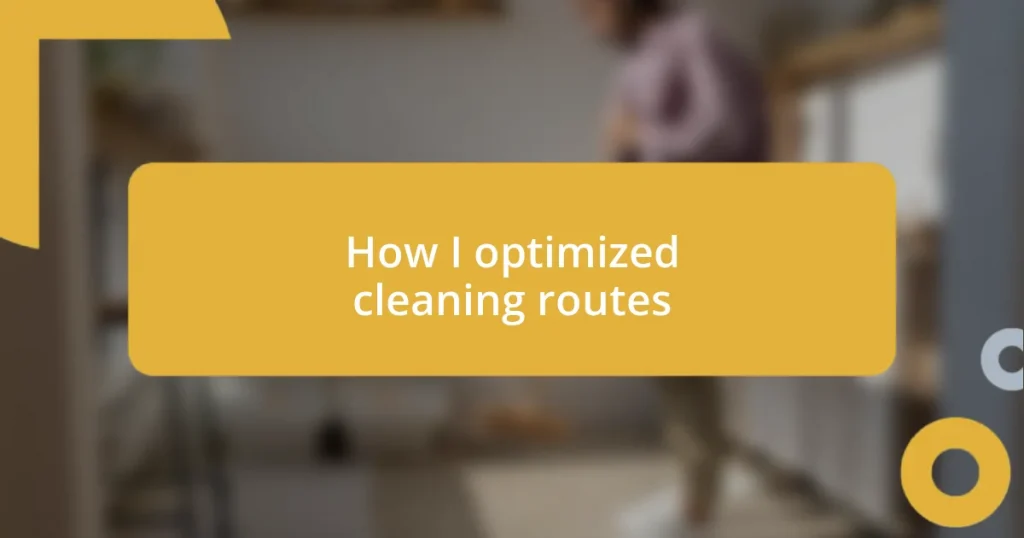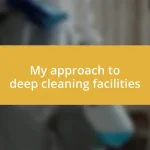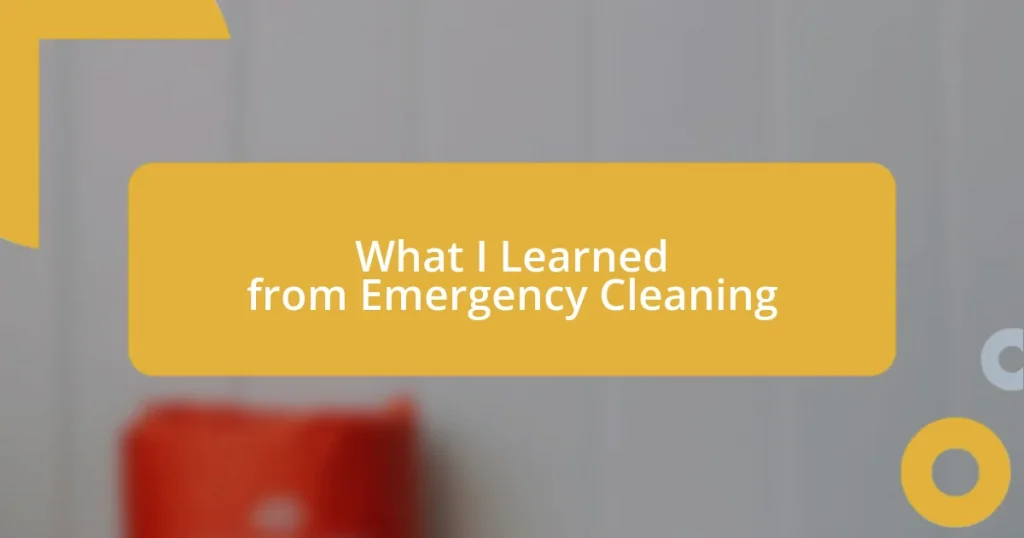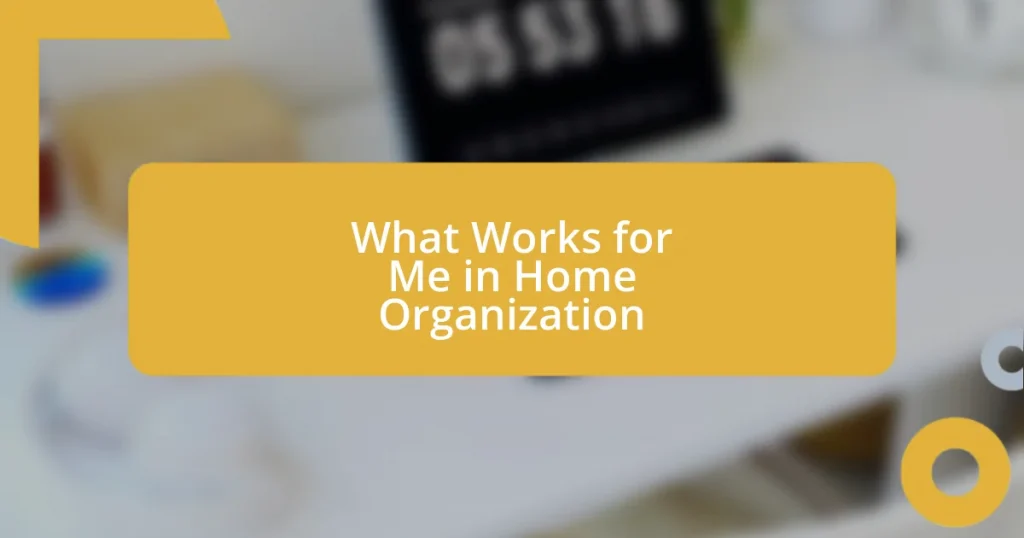Key takeaways:
- Identifying inefficiencies in cleaning routes, such as redundant tasks and unplanned detours, significantly improved productivity and reduced fatigue.
- Utilizing technology, including GPS apps and scheduling software, transformed cleaning processes by optimizing routes and enhancing task management.
- Continuous improvement through regular reassessment and feedback from others led to further refinements in cleaning strategies, making the process more efficient and enjoyable.

Analyzing current cleaning processes
When I dove into analyzing my current cleaning processes, I felt a mix of frustration and discovery. It was surprising to see how inefficient certain routes were; there were times I found myself cleaning a room only to realize I had just been there moments before for a different task. Have you ever felt like you’re just going in circles, literally and figuratively?
I took a closer look at my cleaning routine and noticed the areas where I was doubling back. For example, I used to tackle the kitchen and dining room separately, without realizing I could combine those tasks for a smoother workflow. It was almost like a lightbulb moment for me—what’s the point of walking through the same space multiple times when you can streamline the process?
By mapping out my cleaning routes, I could visualize my movements and optimize them. I remember feeling a sense of accomplishment as I implemented a more structured approach, allowing me to finish my tasks faster. Isn’t it empowering to take control and realize you can make impactful changes in your daily routine?

Identifying inefficiencies in routes
Identifying inefficiencies in my cleaning routes was a game changer. I often noticed wasted time due to backtracking or unnecessary steps. One instance that stood out was when I realized that I frequently moved from the living room to the bathroom and back again. It dawned on me that a simple shift in my approach could save precious minutes and reduce my fatigue.
To effectively pinpoint these inefficiencies, I focused on a few key areas:
- Duplicated Cleanings: Tracking any areas cleaned multiple times during one session.
- Unplanned Detours: Noticing when I made trips to gather supplies midway through my routine.
- Task Clusters: Evaluating whether I could group similar tasks together to minimize movement.
- Equipment Location: Assessing whether the placement of my supplies made sense in relation to my cleaning flow.
Recognizing these patterns not only increased my productivity but also added a sense of satisfaction to my work. I felt more in control and less overwhelmed with each cleaning session, which made the process enjoyable rather than just a chore.

Utilizing technology for route optimization
Utilizing technology for route optimization has been a transformative experience for me. I began integrating GPS-based apps to plan my cleaning routes more effectively. Instead of relying on memory or intuition, these tools offered data-driven insights that significantly reduced my travel time between tasks. Have you ever felt the exhilaration of watching your productivity skyrocket simply because you used the right tools? I know I did, as I transitioned from chaotic movements to a more organized cleaning approach.
Alongside GPS technology, I embraced scheduling software to manage my cleaning assignments. This approach allowed me to visualize not just my tasks, but also the optimal path I’d take to complete them. By analyzing my cleaning patterns over time, I noticed trends that highlighted peak hours versus slower times for various tasks. It was as if I had a secret weapon in my arsenal, helping me conquer my cleaning workload with efficiency and ease. That feeling of clarity was incredibly liberating; I could finally focus on my work rather than juggling chaotic schedules.
Finally, incorporating smart sensors and reminders has brought an element of excitement to my routine. These devices help track my progress and notify me when it’s time to transition from one cleaning area to the next. The enhancement in my workflow was palpable—my cleaning sessions felt purposeful and directed. I remember the pride I felt each time I completed my tasks ahead of schedule, all thanks to a few clever tweaks grounded in technology. When technology aligns with our goals, the positive impact is undeniable!
| Technology | Benefits |
|---|---|
| GPS-based apps | Reduce travel time, optimize routes based on real-time data |
| Scheduling software | Visualize tasks and identify trends for better scheduling |
| Smart sensors and reminders | Track progress and maintain focus during cleaning sessions |

Implementing route optimization strategies
As I dove deeper into route optimization strategies, I discovered the power of creating cleaning checklists tailored to my specific routes. The simple act of listing tasks not only clarified my priorities but also helped me mentally prepare for each cleaning session. Have you ever tried jotting down what you need to accomplish before starting? It made a huge difference for me. This clarity meant I could anticipate my moves and shift gears more smoothly from one area to the next, leading to greater efficiency.
Another key strategy was mapping out my cleaning zones. By literally visualizing my space and breaking it into manageable sections, I felt less overwhelmed. I remember the first day I applied this approach—I set boundaries for each room and assigned specific cleaning tasks per zone. It transformed what used to feel like an endless chore into a series of small, achievable goals. It’s fascinating how a little organization can shift your focus and boost your drive, right?
Finally, after honing in on my strategies, I personally engaged with my methods by tracking my time and reflecting on my progress after each session. I often found myself surprised by how quickly I could complete tasks when I followed my optimized routes. It became almost like a game for me—could I beat my previous time? This newfound sense of competition with myself not only made cleaning feel less burdensome but also infused my routine with motivation. Isn’t it amazing how a little self-reflection can help elevate even the most mundane tasks?

Measuring the effectiveness of changes
To gauge the effectiveness of the changes I implemented, I started with simple metrics—time taken per cleaning session and the number of tasks completed. Tracking these figures made it abundantly clear how much smoother my days had become. It’s like watching the minutes turn into music; every second saved felt like a little victory. Have you ever looked back at your day and thought, “Wow, I really maximized my time”?
As I analyzed my data over weeks, I identified patterns that hinted at further improvements. I recall one period of fine-tuning my routes; there were days I simply couldn’t believe how productive I was. Each time I adjusted my approach, it was as if I discovered a secret level in a video game, unlocking new efficiencies I didn’t know existed. Tracking these changes not only validated my methods but fueled my desire to keep optimizing.
Another telling sign of success was my own mood—less stress and more satisfaction at the end of the day. I could sense a huge difference in my overall well-being when I followed my optimized routes. It’s hard to describe, but when you finish your tasks on time, there’s a sense of accomplishment that seems to ripple into other parts of your life. Isn’t it curious how our workflow can affect our mental state? It’s a reminder that effective changes go beyond the tasks—they shape how we feel about ourselves and our work.

Continuous improvement of cleaning routes
The process of optimizing my cleaning routes is nothing short of a journey in continuous improvement. Initially, I thought I had it all figured out, but I soon realized that even the best plans could be tweaked. I remember the moment I experimented with varying the order of my cleaning tasks. Suddenly, areas felt fresher longer, and I was wrapping up earlier than expected. Have you ever discovered a small change that made a big difference? It’s like finding a shortcut in a familiar city that saves you precious time.
Regularly reassessing my methods became a vital practice. After undertaking several cleanings, I started to notice specific patterns in my approach. Some cleaning tools didn’t bring the efficiency I hoped for, while others were essential. I recall a time when I eliminated a product that just wasn’t living up to my expectations. That single elimination streamlined my process, and I felt lighter—both physically and mentally. Isn’t it refreshing to let go of what weighs us down?
I also found that incorporating feedback—both from my experiences and from a few close friends who helped me tidy up—was invaluable. They pointed out areas where I could work smarter, not harder. The moment I adopted this collaborative mindset, the mundane chore of cleaning became an engaging project. Have you ever involved someone else in your routine tasks for new insights? It’s amazing how fresh perspectives can open doors to continual progress.















